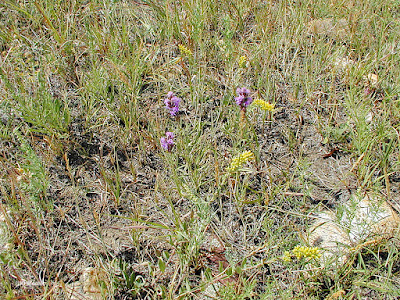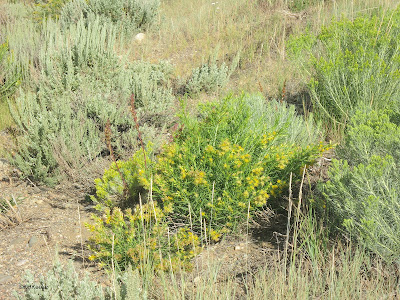I attended Landscaping with Colorado Native Plants conference in February. I came away very conscious of all the differences in gardening between our region and other places, especially the eastern U.S. If you want to grow Colorado natives, they recommended planting in a thick layer of crushed gravel (stone!), adding no fertilizer, washing off the potting soil to plant plants bare-rooted, and within a year, reducing water to once per week or once per month or not at all (that is, depending on rain and snow for water).
 |
| natural vegetation, Colorado grasslands |
We imported our idea of landscape and garden mainly from settlers who came from Kansas or Iowa or Kentucky or Pennsylvania.
All of those places have more, sometimes much more, rain in a year than Colorado. Consequently the familiar and easy-to-grow plants they brought with them were plants of climates with 30 or 60" of precipitation per year, not 15", so needed supplemental water. They installed watering systems to have the usual plants. |
| eastern deciduous forest, Michigan |
Water is the most obvious difference, east to west, but it affects lots of other factors for plants. In the East, the rainfall exceeds the loss of water to evaporation (and transpiration, the loss of water from plants back to the air), and that water runs down through the soil to the groundwater. As it goes, it dissolves any molecules in the soil that are water-soluble and carries them away. Eastern soils are "well-rinsed" with nutrients repeatedly washed away.
About the middle of the continent, in western Iowa and eastern Nebraska, the rainfall is down to about 30" a year. There, with high summer temperatures, the rain becomes inadequate. It hits the soil surface but before it reaches the ground water, it is taken up by plants or evaporates back into the air. This process intensifies as you get farther west with less rainfall and at least as many hot days. Under these conditions, rainwater dissolves the salts in the soil, starts to carry them downward, but stops and leaves them behind, either near the soil surface or actually as a crust on the soil surface, as it evaporates away. Instead of being acidic as eastern soils tend to be, western soils are alkaline from those salts. They are generally poorer in organic matter than eastern soils, because there are fewer plants to deposit leaves and stems and because decay of plant material into organics useable by plants is very slow in dry soils.
In the mountains and foothills, often too, the soils are new, having rather recently broken down from rocks into the small particles characteristic of soils, without much time for organic material to be incorporated.
These are the conditions to which the majority of native Colorado plants are adapted: limited water, alkaline rocky soils with few nutrients, as well as hot dry summers and cold, windy, dry winters.
 |
| a look at Colorado soils (Boulder County) |
Many Colorado natives will grow nicely in moister conditions, watered like a lawn of Kentucky bluegrass (Poa pretense), for example. With more water they get bigger and leafier. But, often, there are serious trade-offs. They get big enough to flop over. They are subject to rotting of the roots or rhizomes and to fungal and bacterial diseases. Some just slowly die, often because wet garden soils have little air in them and Colorado plants expect dry gravely soils with plenty of air pockets.
So as more and more nurseries and landscapers plant Colorado natives, their observations are building a set of recommendations for managing native plants that run counter to all the things I was taught (in New York, Ohio, Michigan, and eastern Nebraska). These suggestions include: mulch with gravel not wood chips; don't add fertilizer; alkaline soils are fine; aerate the soil but don't till it; water only until the roots get established, then drop down to half or less of the water needed for a green Kentucky bluegrass lawn.
Wow.
 |
| Colorado grassland |
For me that is particularly eye-opening because, as you can tell above, I lectured about the differences between ecosystems at the University of Nebraska. I explained soil formation in different regions. I described the conditions that plants adapt to in the eastern and western U.S. But I nevertheless turned my yard into a little corner of upstate New York. That's a terrible use of the limited water in Colorado; it's a shame because I don't have to have a generic yard, I can have a distinctly Colorado one; and it's a whole lot more work to maintain than a yard of plants adapted to this climate.
I thought I was doing pretty well with my yard, but about half of my plants and my watering system could both be replaced to make a more regionally appropriate system. I won't kill the peonies and roses; I'll create a "traditional flower garden" near the vegetable garden. But I hope send drip lines to established trees and shrubs and reduce the regularly-watered zone to just a small part of my yard.
 |
| My yard: lovely but fighting the climate |
I'll be a while getting my head around all the differences. Looking forward to the adventure.
Garden locally.
Comments and corrections welcome.
For more information, search the internet for "gardening with Colorado native plants" and "landscaping with Colorado native plants."
No comments:
Post a Comment